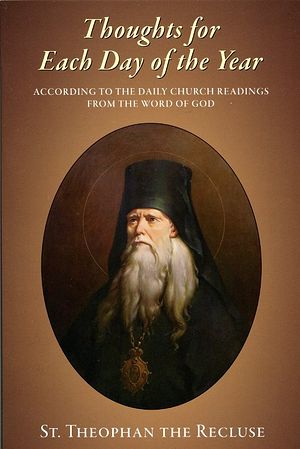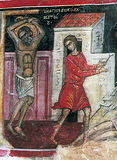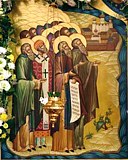

| Previous day | Next day |
| Old Style
August 9
|
Monday |
New Style
August 22
|
|
10th Week after Pentecost.
Tone 8.
Успенский пост. |
Monastic rule: xerophagy (bread, uncooked fruits and vegetables).
|
![]() Holy Apostle Matthias (ca. 63).
Holy Apostle Matthias (ca. 63). ![]() Synaxis of the Saints of Solovki.
Synaxis of the Saints of Solovki.
St. Psoes of Egypt (4th c.). Martyrs Julian, Marcian, John, James, Alexis, Demetrius, Photius (Phocas), Peter, Leontius, Mary the patrician, and others, of Constantinople (730). Martyr Anthony of Alexandria. St. Macarius, founder of Oredezh Monastery (Novgorod) (1532). St. Philaret (Gumilevsky), archbishop of Chernigov (1866).
Icon of the Savior “Not-Made-by- Hands” of Camuliana in Cappadocia (ca. 303).
Thoughts for Each Day of the Year
According to the Daily Church Readings from the Word of God
By St. Theophan the Recluse

Monday. [I Cor. 15:12-19; Matt. 21:18-22]
The Lord condemned the fig tree to fruitlessness because in appearance it was so covered with leaves that there ought to have been fruit on it; however, none could be found. In applying this to the Christian life, the leaves represent outward works of piety and outward spiritual feats, while the fruits represent inner dispositions. This is a law: the former should proceed from the latter. But out of condescension for our infirmity, the latter should in any case develop together with the former. When the former are strong but the latter are not even budding, a lie of life results, which expresses itself like this: to seem, but not to be. At first this unfortunate state is perhaps not in one’s thoughts, but then it appears unnoticeably and establishes itself as a way of life. When one applies himself excessively to externals and becomes passionately attached to them, his attention toward his heart is suppressed, his spiritual feelings die away, and coldness settles in. At this stage spiritual life freezes, and there remains only an appearance of piety, but no piety. The behaviour is proper on the outside, but inwardly to the contrary. The consequence of this is spiritual fruitlessness–deeds are done, but they are all dead.


